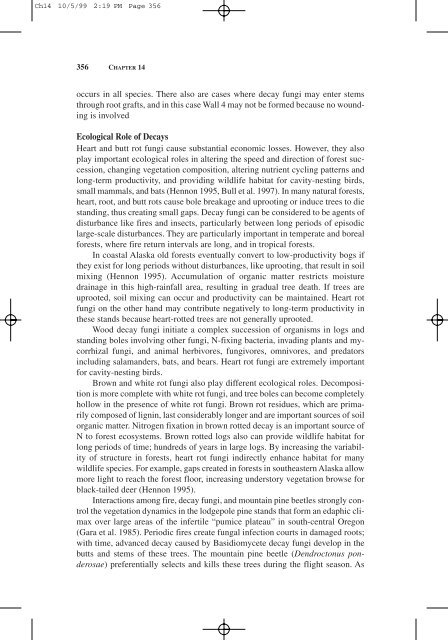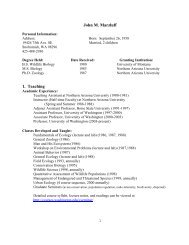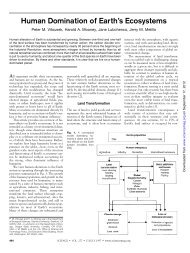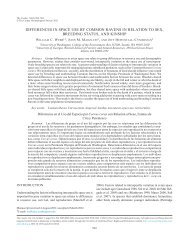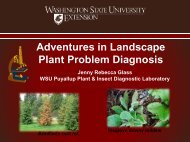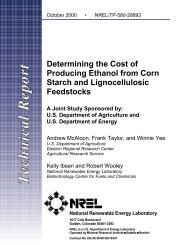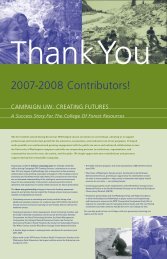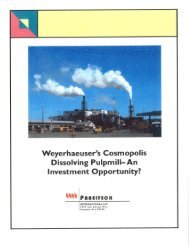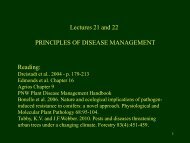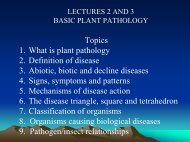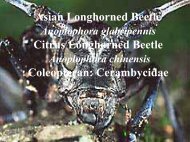You also want an ePaper? Increase the reach of your titles
YUMPU automatically turns print PDFs into web optimized ePapers that Google loves.
Ch14 10/5/99 2:19 PM Page 356<br />
356 CHAPTER 14<br />
occurs in all species. There also are cases where decay fungi may enter stems<br />
through root grafts, and in this case Wall 4 may not be formed because no wounding<br />
is involved<br />
Ecological Role of Decays<br />
Heart and butt rot fungi cause substantial economic losses. However, they also<br />
play important ecological roles in altering the speed and direction of forest succession,<br />
changing vegetation composition, altering nutrient cycling patterns and<br />
long-term productivity, and providing wildlife habitat for cavity-nesting birds,<br />
small mammals, and bats (Hennon 1995, Bull et al. 1997). In many natural forests,<br />
heart, root, and butt rots cause bole breakage and uprooting or induce trees to die<br />
standing, thus creating small gaps. Decay fungi can be considered to be agents of<br />
disturbance like fires and insects, particularly between long periods of episodic<br />
large-scale disturbances. They are particularly important in temperate and boreal<br />
forests, where fire return intervals are long, and in tropical forests.<br />
In coastal Alaska old forests eventually convert to low-productivity bogs if<br />
they exist for long periods without disturbances, like uprooting, that result in soil<br />
mixing (Hennon 1995). Accumulation of organic matter restricts moisture<br />
drainage in this high-rainfall area, resulting in gradual tree death. If trees are<br />
uprooted, soil mixing can occur and productivity can be maintained. Heart rot<br />
fungi on the other hand may contribute negatively to long-term productivity in<br />
these stands because heart-rotted trees are not generally uprooted.<br />
Wood decay fungi initiate a complex succession of organisms in logs and<br />
standing boles involving other fungi, N-fixing bacteria, invading plants and mycorrhizal<br />
fungi, and animal herbivores, fungivores, omnivores, and predators<br />
including salamanders, bats, and bears. Heart rot fungi are extremely important<br />
for cavity-nesting birds.<br />
Brown and white rot fungi also play different ecological roles. Decomposition<br />
is more complete with white rot fungi, and tree boles can become completely<br />
hollow in the presence of white rot fungi. Brown rot residues, which are primarily<br />
composed of lignin, last considerably longer and are important sources of soil<br />
organic matter. Nitrogen fixation in brown rotted decay is an important source of<br />
N to forest ecosystems. Brown rotted logs also can provide wildlife habitat for<br />
long periods of time; hundreds of years in large logs. By increasing the variability<br />
of structure in forests, heart rot fungi indirectly enhance habitat for many<br />
wildlife species. For example, gaps created in forests in southeastern Alaska allow<br />
more light to reach the forest floor, increasing understory vegetation browse for<br />
black-tailed deer (Hennon 1995).<br />
Interactions among fire, decay fungi, and mountain pine beetles strongly control<br />
the vegetation dynamics in the lodgepole pine stands that form an edaphic climax<br />
over large areas of the infertile “pumice plateau” in south-central Oregon<br />
(Gara et al. 1985). Periodic fires create fungal infection courts in damaged roots;<br />
with time, advanced decay caused by Basidiomycete decay fungi develop in the<br />
butts and stems of these trees. The mountain pine beetle (Dendroctonus ponderosae)<br />
preferentially selects and kills these trees during the flight season. As


